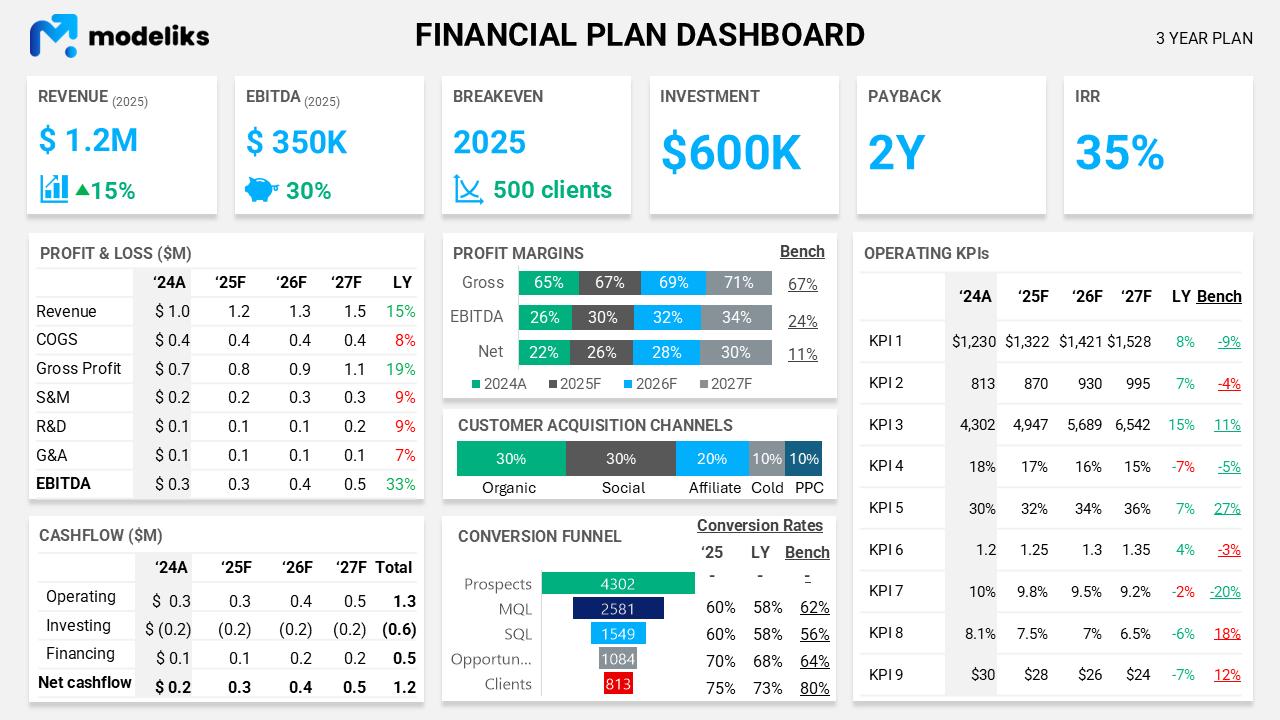Our Real Estate Law Services Financial Model Structure covers all the essential aspects you need to consider when starting or scaling a Real Estate Law Services business. By following this structure, you can better understand your revenue streams, costs, and assets, helping you optimize profitability and strategically plan for growth.
Launching or expanding a Real Estate Law Services business necessitates meticulous financial planning. The financial model for such a business delineates typical revenue streams, direct costs, staffing requirements, expenses, and assets that must be assessed. This strategic blueprint not only ensures smooth operations, but it may also inspire new and profitable revenue streams.
The Real Estate Law Services financial model structure
Revenues:
A Real Estate Law Services business can generate revenue from diverse streams, usually calculated by the fees associated with each service, multiplied by the number of clients or transactions. Here are typical revenue streams:
- Property Transactions: Revenue derived from legal assistance in buying or selling property. Calculate this by multiplying the average transaction fee by the number of transactions.
- Lease Agreements: Income from drafting and reviewing leases, calculated by multiplying the fee per lease by the number of leases.
- Real Estate Litigation: Revenue from representing clients in real estate disputes, estimated based on hourly billing rates and expected case hours.
- Title Searches and Insurance: Generate income from conducting title searches and providing title insurance, based on a per service charge multiplied by the number of services.
- Consultancy Services: Fees obtained from advising clients on real estate matters, calculated using hourly rates over consultancy hours.
- Property Management Legal Support: Earnings from managing legal aspects of property management, derived from service fees per property managed.
- Zoning and Development Approvals: Generate revenue from assisting with zoning or development permissions, based on service fees for approvals.
- Foreclosure Services: Contribute to income by managing foreclosure processes for clients, calculated by multiplying service fees by the number of foreclosures handled.
Cost of goods sold:
Direct costs in Real Estate Law Services are often linked to professional fees and expenses directly tied to each case or transaction. This includes court fees, legal research subscriptions, and costs related to document preparation and filing.
Employees:
Key personnel in a Real Estate Law Services business include:
- Real Estate Lawyers: Handle casework, client meetings, and legal research.
- Paralegals: Assist lawyers by preparing documents, conducting research, and managing client communications.
- Administrative Staff: Manage office operations, including scheduling and billing.
- Financial Officers: Oversee budgeting, accounting, and financial planning.
- Marketing Specialists: Develop and execute marketing strategies to attract new clients.
Operating expenses:
Typical operating expenses include:
- Rent: Costs associated with office space.
- Utilities: Electricity, water, and internet expenses.
- Salaries and Wages: Compensation for all employees.
- Marketing and Advertising: Expenses for promoting services.
- Legal Research Tools: Subscriptions to legal databases.
- Office Supplies: Costs for general office supplies.
- Professional Development: Training and continuing education for staff.
- Insurance: Professional liability and general business insurance.
- Technology and Software: Costs for legal software and IT equipment.
- Client Entertainment: Expenses for entertaining clients and networking.
Assets:
Essential assets include:
- Office Equipment: Computers, printers, and furniture necessary for daily operations.
- Legal Software: Technology solutions for managing cases and client data.
- Library: Legal books and resources for in-depth legal research.
- Vehicles: Transportation for client meetings and court appearances, if necessary.
Funding options:
Common options include:
- Bank Loans: Traditional lending options from financial institutions.
- Angel Investors: Individuals providing capital for equity or convertible debt.
- Venture Capitalists: Firms investing in businesses with high growth potential.
- Business Grants: Non-repayable funds from governmental or private sources.
- Self-Funding: Using personal assets or savings to finance the business.
Driver-based financial model for Real Estate Law Services
A truly professional Real Estate Law Services financial model is based on operating KPIs (Key Performance Indicators) relevant to its operations. These KPIs serve as the foundation for developing a practical and effective financial plan. Examples of such KPIs include:
- Client Acquisition Cost: The total cost spent on acquiring a new client.
- Retention Rate: The percentage of clients retained over a given period.
- Billing Rate per Hour: The average hourly charge for lawyer services.
- Utilization Rate: The percentage of billable hours out of total working hours.
- Realization Rate: The percentage of billed hours that are collected.
- Number of New Cases: The quantity of new cases or transactions acquired.
- Cost Per Case: The average cost incurred for each case handled.
- Revenue Per Client: The average revenue generated from each client.
- Operating Margin: The percentage of revenue left after covering operating expenses.
- Break-even Point: The revenue level at which total costs equal total revenues.
Driver-based financial planning is a process of identifying key activities (often referred to as ‘drivers’) that have the highest impact on your business results, and then building your financial plans based on those activities. It allows you to establish relationships between financial results and the resources needed to achieve those results (like personnel, marketing budgets, equipment, etc.).
If you wish to learn more about driver-based financial planning and its advantages, see the founder of Modeliks explaining it in the video below.
Need a business plan?
Create one with Modeliks AI in the next hour!
AI powered business planning for Startups and SMEs.
The financial plan output
The objective of the financial forecast outputs should enable you, your management, board, or investors to:
- Rapidly grasp how your Real Estate Law Services business will perform in the future.
- Gain assurance that the plan is well-considered, realistic, and achievable.
- Understand what investment is necessary to implement this plan and what the return on investment will be.
To achieve these goals, here is a one-page template demonstrating how to effectively present your financial plan:

Furthermore, aside from this one-page summary of your plan, you will require the three projected financial statements:
- Profit and Loss: A statement illustrating revenue, costs, and profit over time.
- Balance Sheet: A snapshot of your company’s financial position at a specific moment.
- Cash Flow Statement: A document tracking the inflow and outflow of cash.
Real Estate Law Services financial model summary
A professional Real Estate Law Services financial model will help you think through your business, identify resources you need to achieve your targets, set goals, measure performance, raise funding, and make confident decisions to manage and grow your business. Whether you are starting or expanding, having a solid financial model in place is a cornerstone for sustainable business success.
If you need help with your financial plan, try Modeliks , a financial planning solution for SMEs and startups or contact us at contact@modeliks.com and we can help.
Author:
Blagoja Hamamdjiev
, Founder and CEO of
Modeliks
, Entrepreneur, and business planning expert.
In the last 20 years, he helped everything from startups to multi-billion-dollar conglomerates plan, manage, fundraise, and grow.

TAKE MODELIKS FOR A SPIN
Not sure which plan?
Start with a 15 days free trial.
You will have access to the full functionality of Modeliks. The only restriction in the free trial is that you cannot download or share your business plan outside Modeliks. Credit card is not required to subscribe for the free trial.






